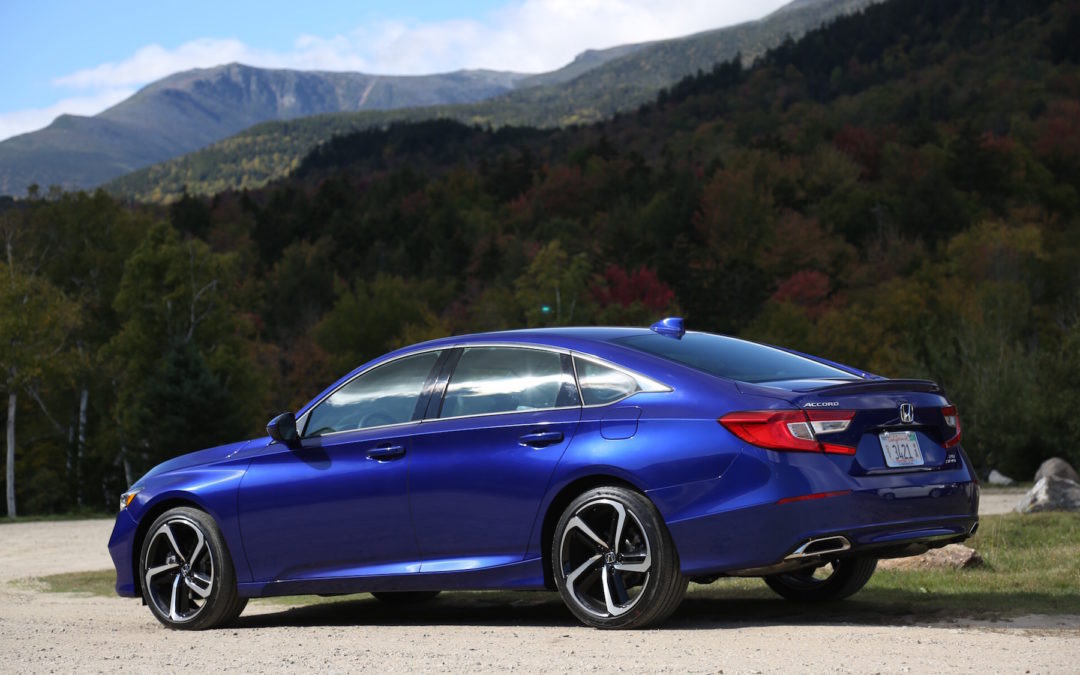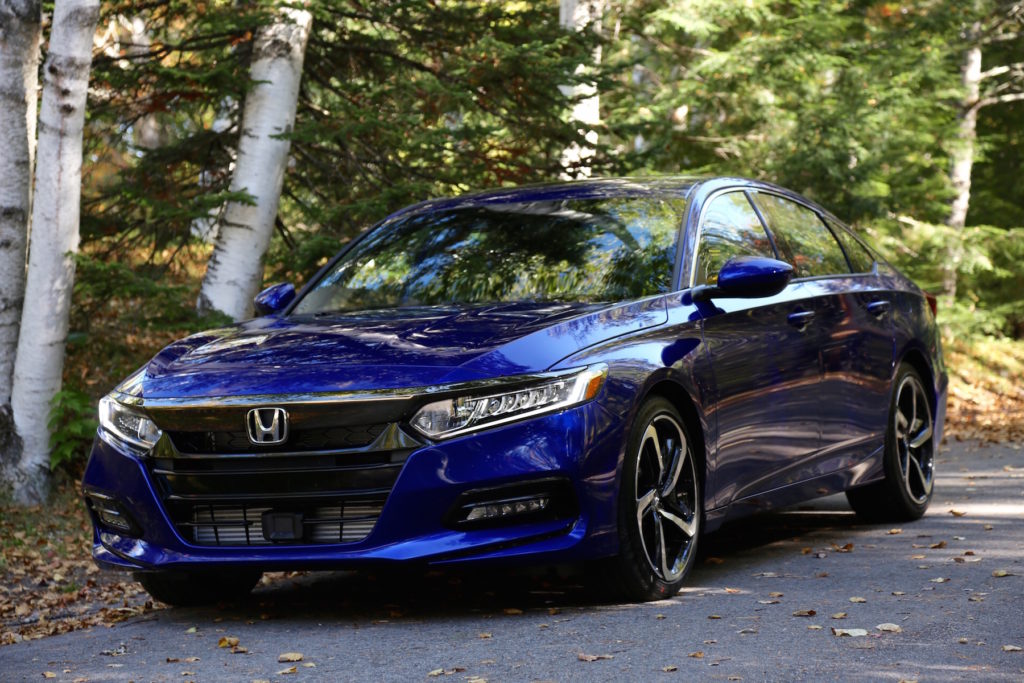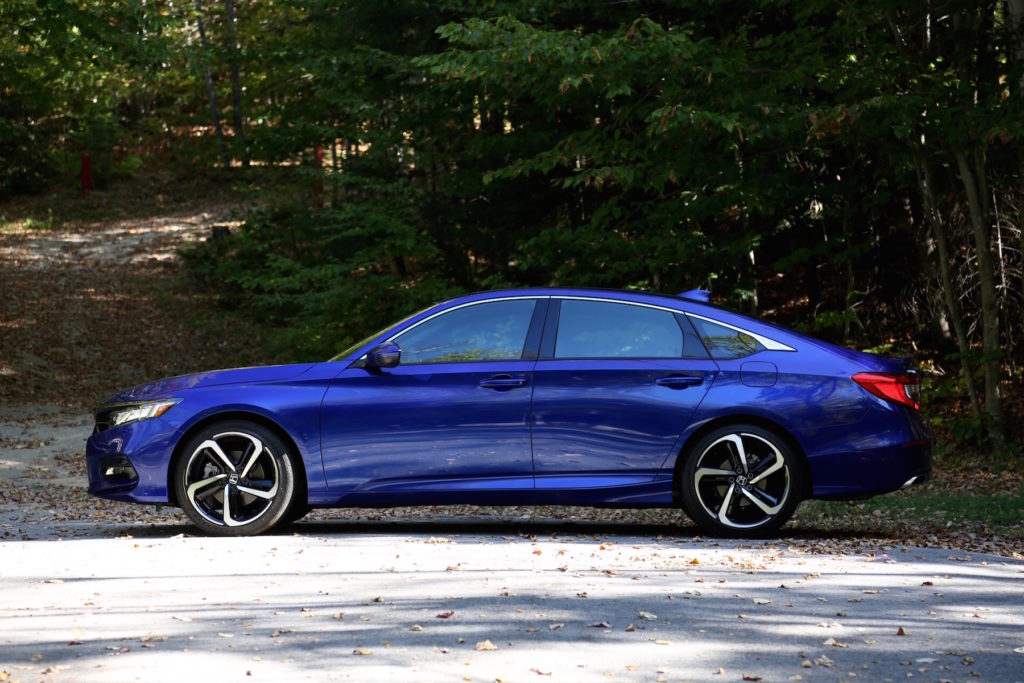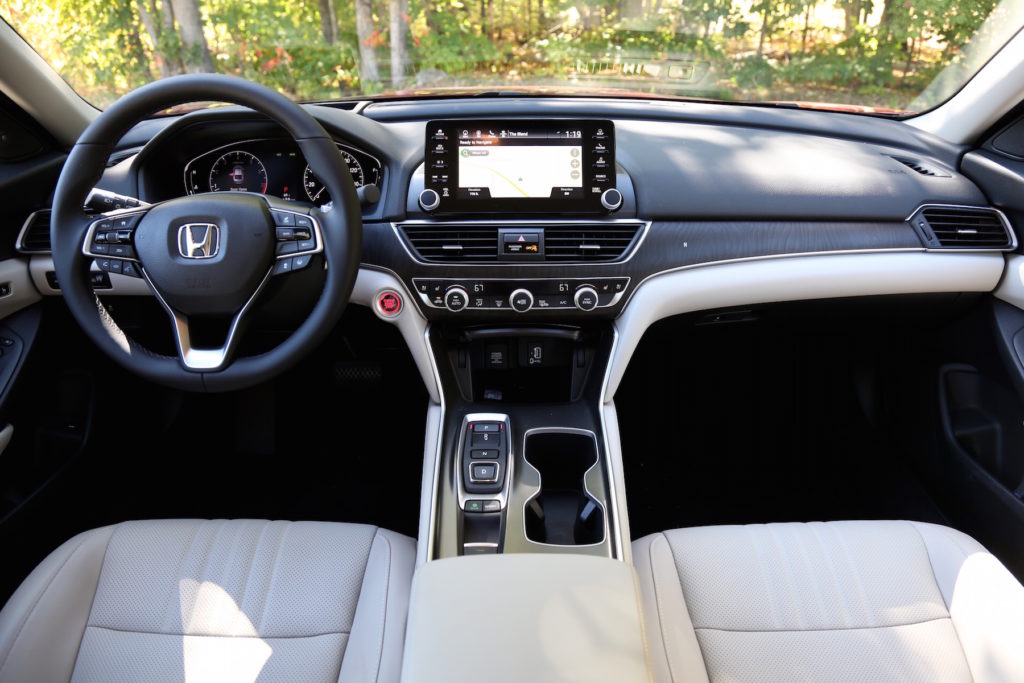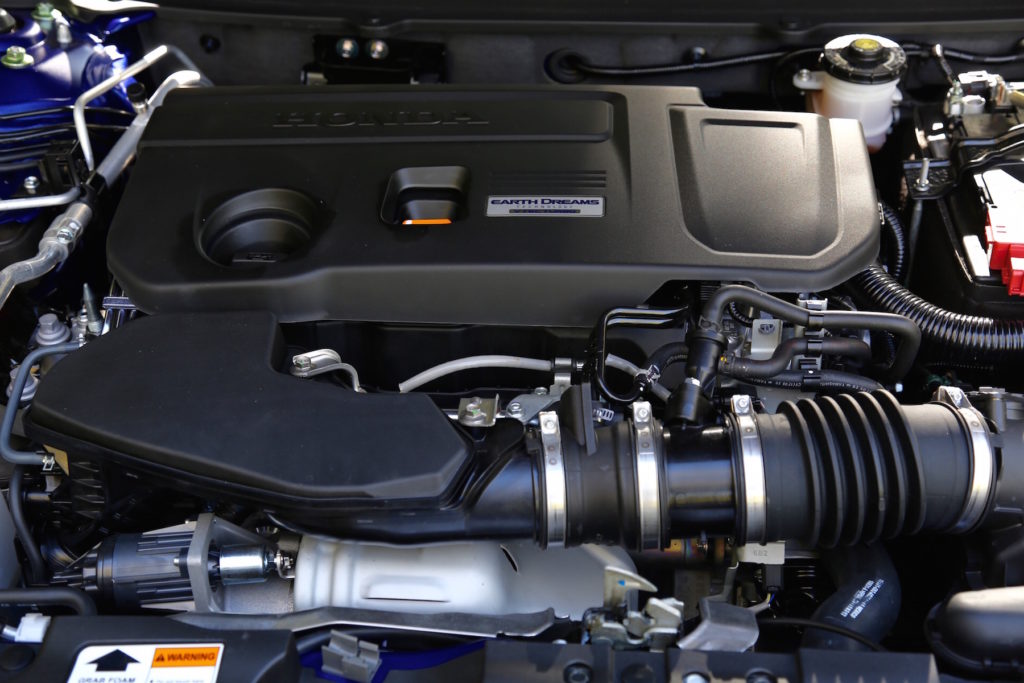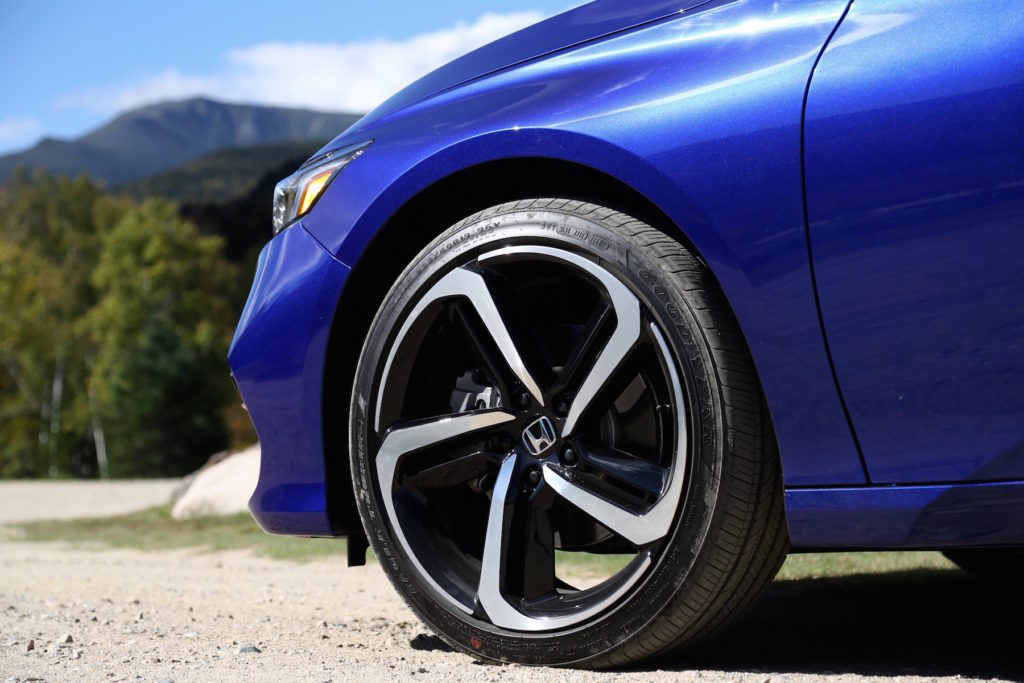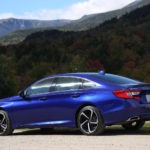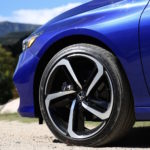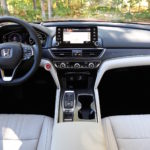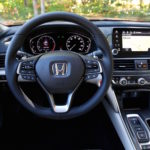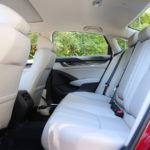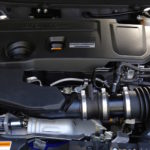A new vehicle generation often brings significant tweaks, but when it comes to the 2018 Honda Accord, it’s easier to note what has not changed (the car’s badges) rather what has (everything else).
Chassis, powertrains, transmissions, suspension, steering, interior and exterior design, convenience features – just about every detail is new or improved. The most feather-ruffling changes include a more sculpted, aerodynamic body, the replacement of Honda’s iconic V6 with a turbocharged four-cylinder, and the loss of a two-door coupe version. Universal wins include greater passenger and cargo space, weight savings, efficiency gains, and standard driver assistance features.
Style and Substance
Designing a midsize sedan is in many ways more difficult than conceiving a sports car. The line between bland and over stylized is razor thin, with most automakers taking a conservative route to navigate this picky group of buyers. The current generation Accord splits the difference nicely with a clean form and eye-catching cues. The redesigned model, by comparison, is bold – very bold.
Honda incorporates a number of styling cues from the 10th generation Civic, including a chrome-winged front fascia, blacked out grill, fastback roofline, and kinked C-pillar.
The 2018 Accord’s lower ride height, wider body, and long hood give it a prowling stance – especially when those LED headlights fill your rearview mirror. Never did we imagine a Honda four-door could look so aggressive.
Our favorite exterior touches include available 19-inch, five-spoke wheels, a shark-like nose, and an elegant roofline. The take-away is a thoroughly upscale physique, albeit with one flub: that caboose.
Like the updated Civic, the new Accord, fails to round out a cohesive design. Instead, the rear end pushes some oversized C-shaped taillights in your face on its way out the door. Perhaps one notch too daring, designers.
The 2018 Honda Accord introduces two new trim levels to (hopefully) give buyers more of what they want, and less of what they don’t. Both powertrain tiers can now mate with Sport and Touring grades, thereby offering style and substance to those who may not want the extra power. Most trim levels also benefit from additional content at a marginal price bump.
Entry-level 1.5-liter LX models come standard with LED headlights and taillights, dual-zone climate control, a digital driver display, push-button ignition, 17-inch alloy wheels, a 7.0-inch display audio system, Bluetooth, USB, automatic headlights, and a multi-view backup camera — all for $23,570 (up $315 from last year). Here’s the real kicker: every 2018 Honda Accord comes with Honda Sensing, the automaker’s full suite of safety technologies.
Technology
In the quest to be cutting edge, sometimes automakers overexert their tech. Such was the case with Honda’s Connect infotainment system, which first appeared in the 10th generation Civic. The idea was good: clean up the center stack with a sharp, touch-sensitive display. Unfortunately, a lack of physical buttons and imperfect touch controls meant a frustrating user experience.
Thankfully, all is made right with Honda’s latest infotainment, the reworked Display Audio system. A 7.0-inch standard or 8.0-inch upgraded screen combines intuitive physical controls with an organized menu and responsive touch inputs. Kudos to Honda for listening to customer feedback and making a quick, smart fix.
Apple CarPlay and Android Auto are standard on EX and above trims, as is Sirius XM, HD Radio, dual USB ports, and remote engine start. Touring trims add Qi wireless phone charging, a 10-speaking audio system, a head-up display, and the next generation of HondaLink Assist (a standalone app to monitor vehicle status, control door locks, or trigger remote vehicle ignition).
Apart from the improved infotainment system, every new Accord features a 7.0-inch full-color TFT display in place of an analog tachometer. The reconfigurable monitor shows media, music, navigation, driver assistance, telemetry data, or a digital tachometer. While not the highest resolution display around, the driver’s meter is a step in the right direction.
Cabin and Cargo
It’s easy to forget about the Accord’s bizarre rump the moment you ease into its restyled cabin. Wide air vents, thin trim panels, and a minimalist center stack communicate cabin volume and premium positioning. Knurled metal climate control knobs, high quality textured plastics, and elegant silver accents enhance every trim level.
Higher spec Accords add soft-leather wrapping for the steering wheel, Zelkova wood trim pieces, and perforated leather seating. Our only misgiving is with the Sport model’s “Arrow Metal” panels, which look and feel cheap – especially in contrast with the rest of the cabin’s fit and finish.
Other triumphs of the 2018 Honda Accord’s interior include 1.9-inches of additional legroom and 0.9 cu. ft. of extra cargo capacity over the current model (for totals of 40.4-inches and 16.7 cu. ft., respectively). A redesigned front seat includes additional lateral bolstering and softer foam padding for a more supportive and comfortable ride. Available front ventilated seats, four-way lumbar support, and heating for rear seat bottoms and backs move the Accord closer to the entry-lux category.
Performance
Great attention was given to the 2018 Honda Accord’s performance and handling, resulting in the most stable, fluid model yet.
Headlining the range of enhancements is a pair of new powertrains – both with forced induction. Customers can choose from a 1.5-liter turbocharged four-cylinder making 192 horsepower and 192 pound-feet of torque or a 2.0-liter turbocharged four-cylinder delivering 252hp and 273 lb-ft of torque. Now you’re waiting for me to say, “ah, but I’ve forgotten the available V6.”Trouble is, I haven’t forgotten – Honda just isn’t offering a six-cylinder engine anymore. Fortunately, the uprated 2.0-liter mill makes more torque than the outgoing 3.5-liter V6; unfortunately, it makes fewer horsepower and loses the V6’s throatier engine note.
1.5-liter models are equipped with either a six-speed manual or CVT (continuously variable transmission). 2.0-liter cars come with a choice of six-speed manual or ten-speed automatic. Yes, enthusiast peeps: you can have a big motor with a shift-it-yourself gearbox. Better still, the 2.0-liter’s six-speed is based on the unit in the Civic Type R, meaning tuners can probably add more power without messing with the gearbox. Honda hasn’t confirmed fuel economy figures, but is targeting 33-combined mpg for CVT models and 28-combined mpg for ten-speed automatic cars. Expect six-speed variants to sacrifice a mpg or two.
A host of chassis and suspension tweaks complement the Accord’s new engines. Updated welding procedures contribute to increased torsional and bending rigidity while cutting weight. Controlling the 2018 Accord’s lighter body is a new front and rear suspension (with adaptive dampers), new front control arm, new rear subframe, and new engine mount.
On the road, these changes add up to remarkable composure in corners, stability under hard braking, and powerful acceleration. 1.5-liter models offer more than sufficient grunt for daily driving maneuvers and 2.0-liter cars feel shockingly similar to sport sedan performance. The ten-speed auto is smooth and responds quickly to paddle shift inputs, Honda’s CVT isn’t as soulless as most, and both six-speeds are well sorted. Part of us misses the imperfect yet scrappy handling characteristics of ancestral Accords, but it’s hard to knock the precision and poise of this latest iteration.
Safety
Passive and active safety gets a major boost with the 2018 Honda Accord. A lower hood, narrower A-pillars, and wider front windshield improve forward visibility. An increase in the use of high-strength steel enhances crash protection. An upgraded 6.0-inch head-up display with traffic sign recognition, turn-by-turn directions, and driver aid warnings reduce distractions.
Most importantly, Honda Sensing – standard on every trim – features a solid set of active safety technologies. Included across the board is collision mitigation braking with forward collision warning, road departure mitigation with lane departure warning, adaptive cruise control with low-speed follow, lane keeping assist, traffic sign recognition, and a driver attention monitor. EX and above trims add blind spot monitoring and cross traffic alerts. Finally, Touring trims add front and rear parking sensors.
Within the midsize sedan segment, other automakers have introduced driver aids at all trim levels, but none are as robust as Honda Sensing.
The Verdict
To develop its 10th generation Accord, Honda whipped out the magnifying glass and hyper analyzed every detail of its midsize offering. For some cars, this blank-sheet redesign would be necessary, but the current Accord is selling in record numbers. So why did Honda remake the wheel (both figuratively and literally)? It boils down to confidence – in its engineers, designers, and customers.
Even before the Accord hits showrooms, we’re convinced: Honda’s gamble and grit will pay off.

